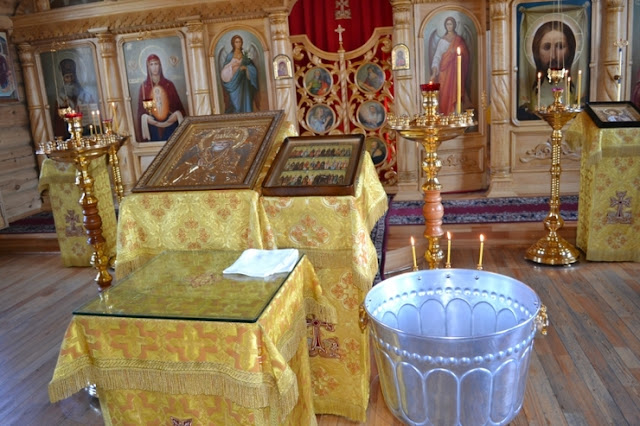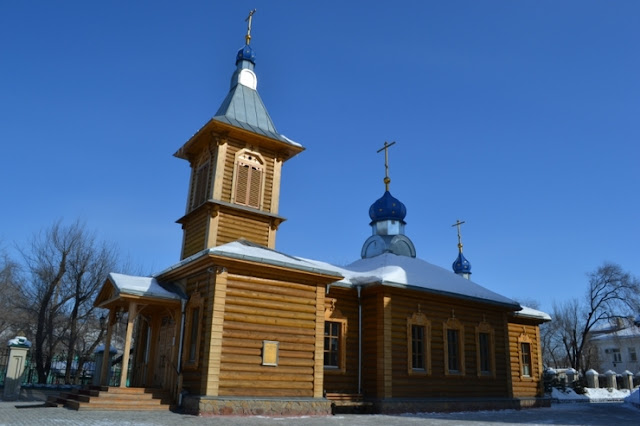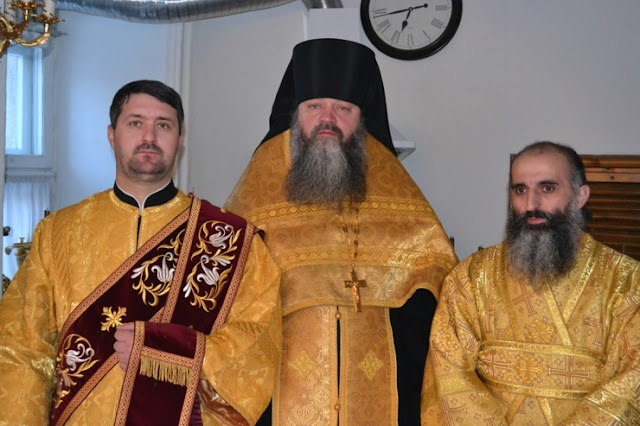My name is
Svyatoslav Shevchenko, I am an Orthodox priest. I serve in the cathedral church
of the city of Blagoveshchensk (Amur region) and work as the head of the press service
in the diocese of Blagoveshchensk.
We live on the
western outpost of Russia, which borders with China. On the other bank of
the Amur river (its width is about 800-1000 m) you can see the Chinese city
Heihe, province Heilongjiang.
On February 23 I
have spent the whole day with my camera to tell you about my average day as a
priest.
On February 23,
which is a Defender of the Fatherland Day in Russia, it was my turn to serve the
liturgy. When I have to serve, I wake up quite early, as I should be in the
church at 8 a.m.
Of course, I
read morning prayers (How can a priest act without prayer?). I am not supposed
to breakfast, as the Divine Liturgy is a shell for the Sacrament of the
Communion. The communion is the meeting with God, and this is why Orthodox
Christians take the communion on an empty stomach.
I start the
engine of my “Niva” and warm it up. I inherited
this cherry-colored offroader from my father.
In this cold
morning looming (actually, it is not as cold as it may seem, it is only -20 C)
you can see the lighting of the Cathedral of the Annunciation.
However, the service
will be held in another church, the Church in honor of St. Nicholas, which
is not far from the Cathedral. This is not just a church, but a monument. Many years ago this
church became the first building in the city. The emperor Nicholas II, who
visited that area of Amur in the end of the 19th century, became the
patron of the Church of St. Nicholas. After the revolution the church lost its dome.
A post-office, a nursery and dermatovenerologic hospital were disposed in that
building. Unfortunately, in 1980 the domeless church was destroyed entirely. In
2010 it was reconstructed.
The sun rose, when I parked near the church. Did I mention that the church has the
shape of a ship? There is a symbolic meaning: churches are our ships, by which
we sail across the sea of our life.
The wooden
church welcomes us with its prayerful atmosphere.
I entered the altar,
a room, which is separated from the rest of the church with the iconostasis (a
wall consisting of icons). The altar symbolizes the Heavens. Inside there is the the altar table and the table of oblation. On the altar table there is a Gospel, crosses, a seven branched candelabrum
and a portable tabernacle, in which the holy sacraments for sick people are
kept.
And here is the table of oblation, on which the proskomedia is held. It is the first phase of the Divine
Liturgy, which symbolizes the Nativity of Christ and His preparation for crucifixion.
During this phase bread and wine are prepared for the Eucharist. Small pieces
of bread, which symbolize living and the deceased, are taken out of prosphora.
The deacon
(the third position in the clergy) censes around the altar. Before the liturgy
starts, he censes the whole church.
The Divine
Liturgy begins. The Priest (your humble servant) stands in front of the altar table,
and the deacon comes to the ambon (a small round hill in the church) and reads
the litany (prayerful requests). Now it is 9:10 a.m.
After the priest cames out with the Gospel,
which symbolizes Christ beginning His preaching, the priest and the deacon pray
for the help of the living and for the repose of the dead.
Now the Liturgy
of the Faithful begins, which is the second phase of the Divine Liturgy. During the first
centuries of Christianity, not only Christians could present at that liturgy,
but pagans, who were going to be baptized as well. The priest opens the
antimension – a piece of cloth with the image of crucified Christ. A piece of a
saint’s holy relics is sewed in it, as ancient Christians served liturgy on the
graves of Christians, who were executed for Christ.
The Cherubic Hymn sounds. This is one of the most important moments of the liturgy, symbolizing
Christ voluntary going to the cross. During the Cherubikc Hymn the prepared sacraments (Blood and Body of Christ) are moved from the credence to the altar.
And now the crucified
Christ is covered with a shroud.
The Anaphora. It is the most important moment of the liturgy. The priest is asking God that
He bless the sacraments with the Holy Spirit, so that people can take the Communion. At this moment it is 10:00 a.m.
On this photo
you can see me putting the Body of Christ into the Blood. The clergy in the
altar are going to partake of the Holy Communion. After this the laity in the church will
take the Communion as well.
As soon as the
liturgy ended, the baptism began. It is usually held in the Church of St.
Nicholas at 11 a.m. The picture was taken after the end of the sacrament.
At 1:00 p.m. I
have lunch in the Cathedral’s fratery – pea soup, and crushed potatoes with
meat grease. At lunch I was accompanied by Father Alexander, one of the other priests.
When I was
leaving, the sun was at the zenith. The smell of spring was in the air.
My two sons
were waiting for me at home, as they wanted me to keep my promise – to bring
them to the “snow town” for children, organized on the central square of the
city. On the background you can see how unusual our home looks like. We live on
the mansard, which was a workshop many years ago.
We are in
the city center. On the background there is a city administration building.
Before the revolution it was the house of a rich merchant.
The boys rushed
to the snow slides.
How little
it takes to make a child happy!
At 5:00
p.m. I have to serve a bishop service in Cathedral of the
Annunciation. This is how the altar of the cathedral looks like.
Let me inroduce you our international clergy
team in honor of Friendship of the nations: protodeacon John (Moldova), abbot Innocent
(Ukraine), monk and subdeacon Martin (Ossetia). The all-night vigil is coming
to an end. It is 6:45 p.m.
Bishop Lukian
of Blagoveshchensk and Tynda has just anointed people in the church.
I come
home. The boys are hanging on the bar. They wrestle and have already won
several awards on the local wrestling contests. Tomorrow will be a big day for
them, as they will take part in the regional contest.
Children have
prayed, asked their father for a blessing and gone to bed. I take the last picture,
because my camera is tired after such a full day and is about to shut down. My
wife and I read the evening prayers and go to sleep too.
Translated
from: http://maxpark.com/community/2883/content/1844148












































CONVERSATION